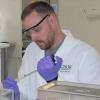Hello LongeCity community! We received around 30 samples from you to test in our laboratory, some home-brews and some from 3rd party vendors. We have completed HPLC testing for C60 concentrations within the samples. Several of you requested that your samples be made anonymous, so we have decided to release a compiled graph of concentrations measured from 3rd party vendors. To receive your individual sample results, please PM me and I will provide those to you. ![]()
Disclaimer: Ichor has conducted this testing under research grade conditions as a free service to the LongeCity community. Members of the Ichor staff hold equity positions in BioSenex, Ltd. None of these staff members were involved in the testing or handling of any of these samples. Neither Ichor nor any of its employees hold equity positions or receive compensation from any of the distributors listed.
Carbon60OliveOil.com
Concentration claimed: 800ug/mL
Concentration measured: 825ug/mL +/- 25ug/mL
Samples tested: 5
Vaughter Wellness
Concentration claimed: 900ug/mL
Concentration measured: 531 +/- 24ug/mL
Samples tested: 3
SES Research
Concentration claimed: 800ug/mL
Concentration measured: 563ug/mL +/- 19ug/mL
Samples tested: 9

We are still debating what, if any, additional analytical testing should be done. If you have input on interesting things for us to look for please post here and we will take your suggestions into consideration.





























































